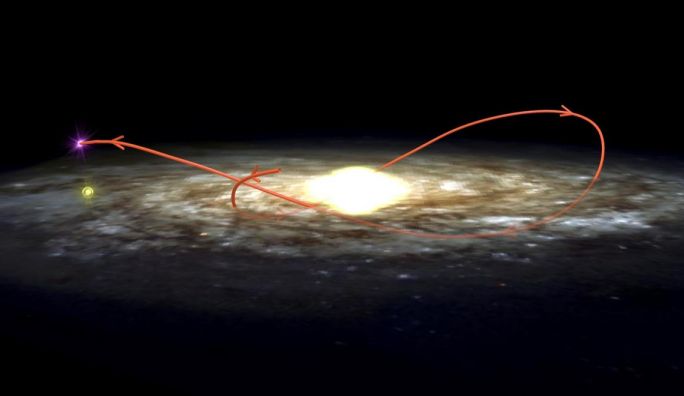
|
Credit & Copyright: I. Rodrigues and
I. F. Mirabel
(IAFE,
SAp/CEA) et al.,
NRAO,
AUI,
NSF
(Orbit Illustration)
Explanation:
Black hole candidate XTE J1118+480 is known to roam the halo
of our Milky Way Galaxy.
This exotic
system - thought to be a
stellar mass black hole consuming
matter from a companion star - was discovered only last year as a
flaring celestial x-ray source.
Suggestively termed a
microquasar,
recent radio and archival optical observations of
its
motion through the sky have now allowed its
orbit to be calculated.
Illustrated above, the
black hole's present galactic location is
indicated by the purple dot, with the
Sun's position in yellow.
A mere 6,000 light-years from the Sun now, XTE J1118+480's orbit is
traced by the orange line, backtracked for some 230 million years into
the past based on models of the Galaxy.
Astronomers note this black hole's orbit about the galactic center,
looping high above and below
the Galaxy's
plane of gas, dust,and stars,
is similar to orbits of globular
star clusters,
ancient denizens of our Galaxy.
It seems likely that
XTE J1118+480 too has its origins in the early
history and
halo of the Milky Way.
(Orbit Illustration)
|
January February March April May June July August September October November December |
| ||||||||||||||||||||||||||||||||||||||||||||||||
NASA Web Site Statements, Warnings, and Disclaimers
NASA Official: Jay Norris. Specific rights apply.
A service of: LHEA at NASA / GSFC
& Michigan Tech. U.
Based on Astronomy Picture
Of the Day
Publications with keywords: black hole - XTE J1118+480 - microquasar
Publications with words: black hole - XTE J1118+480 - microquasar
See also:
- APOD: 2025 December 3 Á Visualization: Near a Black Hole and Disk
- APOD: 2025 September 24 Á GW250114: Rotating Black Holes Collide
- APOD: 2025 May 9 Á IXPE Explores a Black Hole Jet
- APOD: 2025 May 6 Á The Doubly Warped World of Binary Black Holes
- APOD: 2025 May 4 Á Spin up of a Supermassive Black Hole
- APOD: 2024 November 24 Á Journey to the Center of the Galaxy
- APOD: 2024 October 1 Á Porphyrion: The Longest Known Black Hole Jets
